The best probe thermometer
ThermoWorks sweeps the field.

By Michael Sullivan
This post was done in partnership with Wirecutter. When readers choose to buy Wirecutter's independently chosen editorial picks, Wirecutter and Engadget may earn affiliate commission. Read the full guide to probe thermometer.
After spending 20 hours testing probe thermometers and speaking with experts—including cookbook authors, chefs, butchers, and a New York City Department of Health employee—we think most cooks just need a regular meat thermometer. But if you're set on getting a probe thermometer to measure the temperature of food while it cooks, we recommend the ThermoWorks Dot. In our tests, the Dot was the fastest and most accurate at reading temperatures. Its simple design and straightforward controls made it easier to use than the competition.
The ThermoWorks Dot is accurate, affordable, and easy to use. It has a very wide temperature range, as it's capable of measuring from -58 °F to 572 °F. It also has one of the longest probe cables of any of the thermometers we considered. The digital display on the ThermoWorks Dot is easily readable, and we thought the controls were straightforward and intuitive. We also like its backlit screen, which is handy for outdoor grilling at night.
If you're looking for a few more helpful features, the ThermoWorks ChefAlarm includes a timer and volume adjustment as well as a backlit screen. In our tests, though the ChefAlarm was a couple of seconds slower than the Dot at reading temperatures, it was just as accurate. We especially liked the convenience of the timer on this model. The digital unit is also hinged, so you can lay it flat or adjust it to a specific angle. Unlike our other picks, the ChefAlarm thermometer comes with a case to hold the probe and the digital unit.
Unlike our other picks, the ThermoWorks Smoke can operate via a wireless receiver and has two channels to accommodate multiple probes: one probe to take the internal temperature of the meat, and an air probe for measuring the ambient temperature of the oven, grill, or smoker. In our tests, the Smoke maintained its wireless connection for an unobstructed distance of 350 feet. It has a backlit screen and volume control, but no timer, and because it's $60 more than our main pick, we recommend it only for grill and smoker enthusiasts.
Why you should trust us
For this guide, we spoke to food professionals including barbecue and grilling expert Rick Browne, creator, host, and executive producer of PBS's Barbecue America television series, as well as the author of more than 10 cookbooks; Janet Crandall, a private chef, formerly the executive chef and head butcher for Wyebrook Farm in Honey Brook, Pennsylvania, a butcher at Pat LaFrieda Meat Purveyors, and an instructor at the International Culinary Center; and Robert D. Edman, assistant commissioner of the Bureau of Food Safety and Community Sanitation, New York City Department of Health.
We also consulted reviews from Cook's Illustrated (subscription required), Consumer Reports (subscription required), and AmazingRibs.com, and we looked at customer reviews on Amazon.com.
Michael Sullivan spent over 20 hours testing probe thermometers for this guide. Previously he tested gas grills and charcoal grills, as well as grill accessories, for Wirecutter.
Probe thermometers versus instant-read thermometers

Everyone should have a meat thermometer in their kitchen to ensure they're consuming food cooked to safe internal temperatures. The more common kind is an instant-read thermometer, which you can stick directly into food for a few seconds to check the temperature. A probe thermometer is the kind of meat thermometer that is intended to remain in the meat while it cooks. A heat-safe cable attaches the probe to a digital unit outside the oven that displays the temperature reading.
You can take the internal temperature of meat using either type of thermometer. Most of the pros we spoke to recommended getting an instant-read thermometer over a probe thermometer, because they're faster at reading temperatures and longer lasting.
The advantage of probe thermometers is that you get an alert as soon as a set temperature is reached, without your having to open the oven door. The disadvantage of probe thermometers is that they're typically slower at reading temperatures. The probe attachments also have a high failure rate (the probe is subjected to high heat, and the cable frequently sustains damage due to the pressure from an oven door or grill lid) but are available for purchase separately when you need to replace them. That said, some people still like using probe thermometers, as they can remain in the meat during cooking.
If you use a probe thermometer, keep in mind that the probe measures only the area of the meat it's touching. Rick Browne told us, "The probe is sort of letting people know the temperature, and it's a good guideline, and then you can refine it with the instant-read and take multiple readings." You need to know where to place the probe thermometer to correctly measure the internal temperature of the meat—a challenge, particularly for beginner cooks. According to Robert D. Edman, assistant commissioner of New York City's Bureau of Food Safety and Community Sanitation, "The probe should be inserted into the thickest part of the meat, poultry, or poultry parts, away from bone, fat, or gristle. When taking the temperature of beef, pork, or lamb roasts, the probe should be inserted midway into the roast, avoiding the bone. The core temperature is what is being determined." (Chef Janet Crandall told us that bones conduct more heat and will give you a higher temperature reading.) For thinner proteins, such as fish fillets, you should insert the probe sideways. If you're uncertain about the proper placement or final temperature of the meat you're cooking, most of the pros we spoke to recommended taking multiple readings using an instant-read thermometer.
How we picked and tested

A good probe thermometer should quickly and accurately give a temperature reading so that you know when your food, particularly meat and poultry, is safe to eat. It should have a wide temperature range to accommodate both oven and grill use, and it should be intuitive to operate. Longer probes will ensure that you're reaching the thickest part of large roasts, or the bottom of a saucepan for frying or for making candy.
For this guide, we've tested 14 probe thermometers ranging from about $17 to $100. We looked at three main types:
Basic thermometers with a single probe that display readings on a digital unit
Dual-channel thermometers that have two probes (one for taking the internal temperature of the meat and another for reading the ambient cooking temperature) and display readings on a digital unit
Remote probe thermometers that display readings on battery-operated wireless receivers or through smartphone apps via Bluetooth
We tested probe thermometers with temperature ranges between –58 degrees and 572 degrees Fahrenheit, with probe cables heat-resistant up to 712 °F. Cheaper models around $20 typically have temperature ranges of 32 °F to 392 °F, which means you can't use them for most high-temperature cooking, such as frying or grilling.
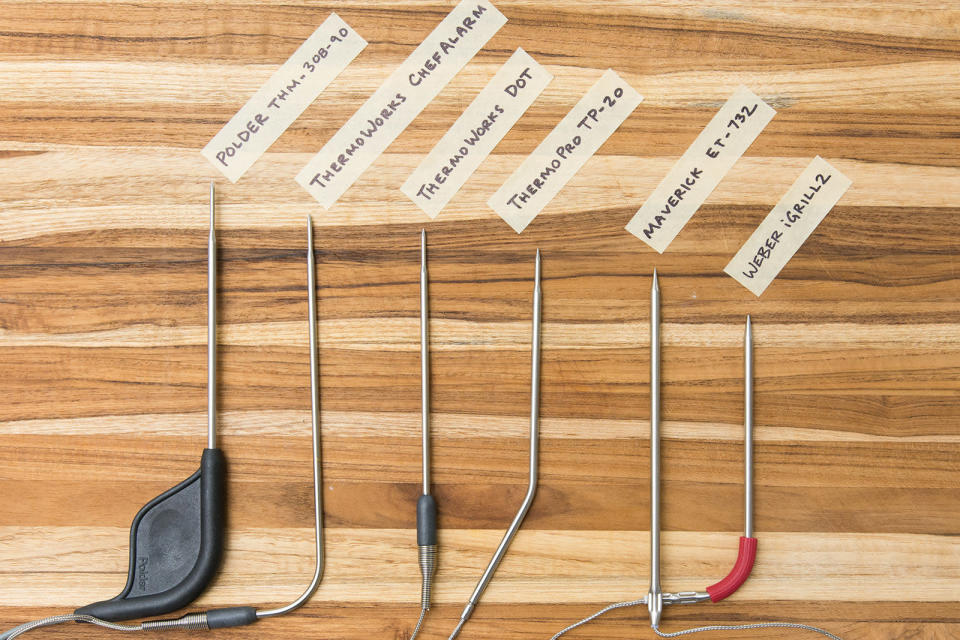
The length of the probe is important, to ensure you're reaching the thickest part of large roasts such as pork shoulder. Also, if the length of the probe is too short, you won't be able to reach the bottom of a saucepan for making candy. Ideally, the cable that attaches the probe to the digital unit should be able to withstand temperatures up to 700 °F for safe use on a grill without damage.
We looked for models that were intuitive to operate, with digital displays that were easy to read. Most probe thermometers come with preprogrammed temperature settings, though chef Janet Crandall told us, "I never follow the preprogrammed settings. For example, the FDA says you should cook chicken to 165 °F, which I think is too high. I prefer 145 to 150 °F, and as you let it rest it will continue to climb another 10 degrees." The pros we spoke to said it's always best to program your own temperature settings to avoid overcooking your meat.
We tested dual-channel thermometers, which have two probes: one for taking the internal temperature of the meat, and an air probe for measuring the ambient temperature of an oven, grill, or smoker. However, Rick Browne told us he doesn't recommend using air probes for grills because grills are prone to hot and cold spots, adding that "the difference in temperature from the surface of the grill to the top of the lid varies a lot." Browne recommends holding your hand a couple of inches off the grill grate to gauge the heat level: If you can hold it for three seconds, that means the heat is low, while two seconds indicates medium heat and one second means high heat.
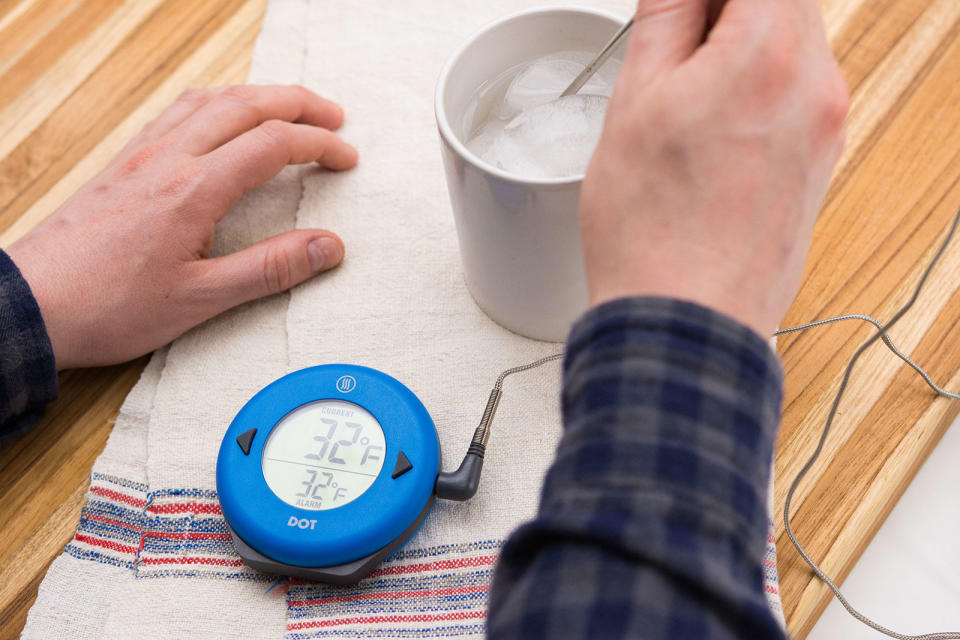
We also tested remote probe thermometers with wireless receivers, which allow you to walk away from a grill or smoker but still monitor the food you're cooking. However, Rick Browne said, "Often I find it's the gadget guy, the guy who wants every gadget known to man for his barbecue and his car and his golf bag and everything else, who says, 'Oh, I've got to have [a remote probe thermometer].' And he gets it, uses it a couple of times, and then finds out that it really doesn't work that well and then stops using it." After testing, we've concluded that remote thermometers are a convenience item most people can do without.
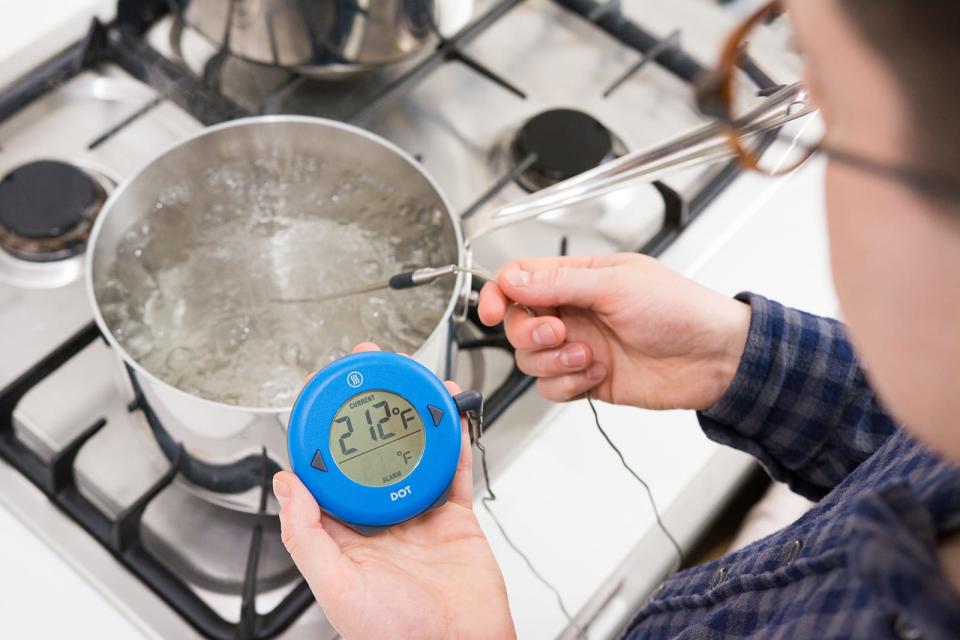
To check the accuracy of the thermometers, we inserted their probes into a ceramic mug filled with ice water (32 °F), which is what most manufacturers recommend for proper calibration. We also tested the probes in a pot of boiling water. Because changes in atmospheric pressure and elevation will affect the temperature at which water boils, we used ThermoWorks's boiling-point calculator to determine that the boiling point at our testing location is 212 °F. We also inserted the probes into a stockpot of 130 °F water maintained by a sous vide circulator. In each test, we timed how long each thermometer took to register the correct temperatures.
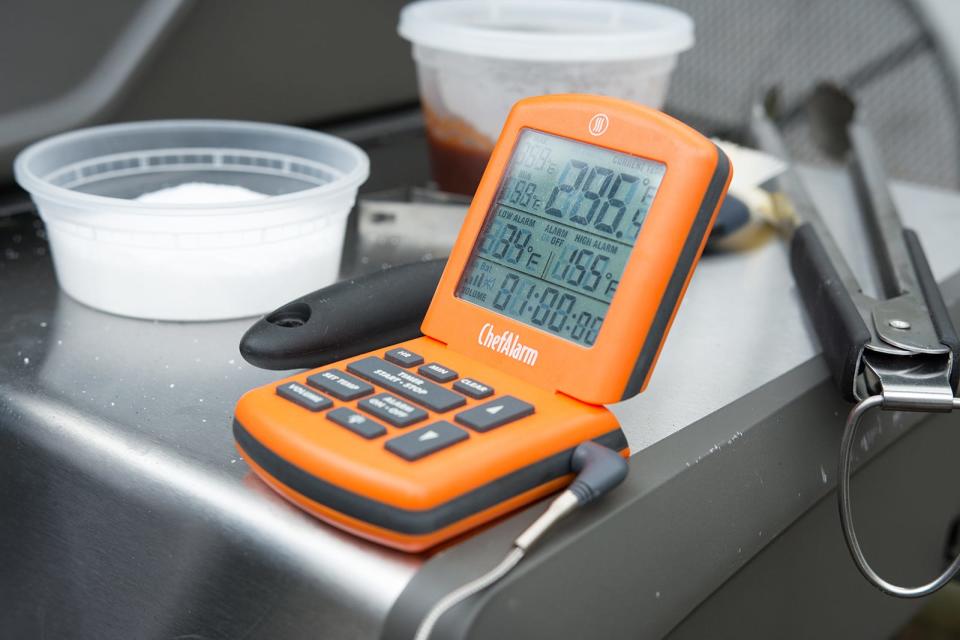
To test the durability of the probe cables at high temperatures, we used our finalists in a screaming-hot, 650 °F to 700 °F grill. After our initial round of testing, we used the remaining contenders to monitor the temperature of oven-baked chicken pieces to get a feel for their usability.
We evaluated the strength of the magnets on the back of the digital receivers to see how well they could stay attached to the side of an oven or grill. Finally, we measured the distance from which remote probe thermometers could function before losing their wireless connection.
Our pick: ThermoWorks Dot
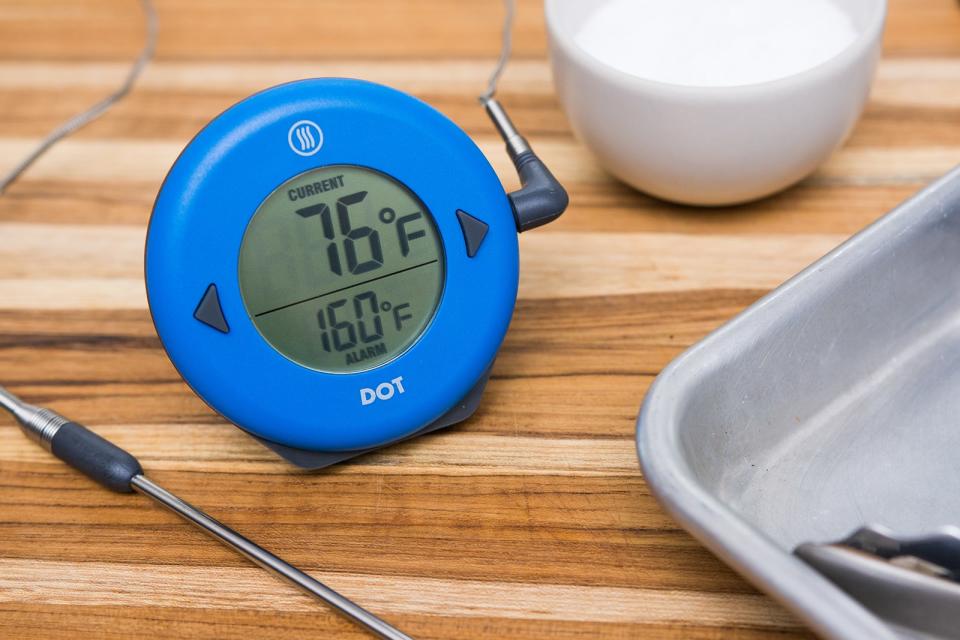
We recommend the affordable ThermoWorks Dot probe thermometer for its impressive accuracy and ability to read temperatures quickly. Compared with the others we tested, it was the easiest thermometer to use, thanks to its simple, intuitive design and large digital display. The Dot's wide temperature range makes it ideal for both oven and grill use, and its backlit screen makes it easy to read in any light.
In our tests, the Dot was the fastest thermometer to read temperatures accurately. On average, it was able to read 32 °F in about 8.5 seconds and 212 °F in about 5.5 seconds. Its thermistor sensor has an impressive temperature range of -58 °F to 572 °F (and a cable that can withstand 700 °F for short periods of time), unlike many other models, which typically have a much smaller range. The Dot was one of only three tested models that were accurate to the degree in a stockpot of 130 °F water maintained by a sous vide circulator.
The Dot also had one of the longest cables—about 48 inches—of the models we tested. The cable became slightly discolored and stiff when we subjected it to the high heat of a grill, but that had no effect on the thermometer's performance. And since its 4½-inch probe is slightly longer than that of our upgrade pick for instant-read thermometers, the ThermoWorks Thermapen Mk4, it will have no problem reading the internal temperature of large roasts.

The Dot's simple design and straightforward controls made it easier to use than the competition. This model has an on/off switch on the back of the unit, with arrow buttons on the side of the digital screen that allow you to set your desired temperature. After you insert the probe into your food, the alarm beeps to alert you when the set temperature has been reached. You can press any button on the interface to stop the alarm; to disable the alarm altogether, simply hold the two arrows down at the same time. You can also switch from Fahrenheit to Celsius by holding the power button for six seconds while turning the unit on. Also, among the probe thermometers we tested, the Dot had some of the strongest magnets, which kept it securely attached to the side of our oven. It's available in a variety of colors, too (nine in all).
The ThermoWorks Dot boasts an Ingress Protection rating of IP65, which means the body of the unit is protected against the entry of dust and "low-pressure jets of water." It also comes with a two-year warranty, and the probe is replaceable. Contact ThermoWorks if you encounter problems with the Dot under normal household use.
This model is also available with Bluetooth, sold under the name BlueDot, for about $20 more (at the time of this publishing). It has all of the same controls as the regular Dot thermometer, but it can also connect to an app on your phone, which allows you to monitor the food you're cooking from a distance. It's a nice added feature, but we think most people will be happy without it.
Flaws but not dealbreakers
The ThermoWorks Dot doesn't come with a metal clip that attaches the probe to the side of a saucepan for tasks such as frying or candy making, but all ThermoWorks accessories (including probe clips, grate clips, and air probes) are sold separately.
The Dot lacks a timer and preprogrammed temperature settings. However, since the pros we spoke with don't recommend using preset temperatures anyway, we don't think this omission is a dealbreaker.
Also great: ThermoWorks ChefAlarm and Smoke
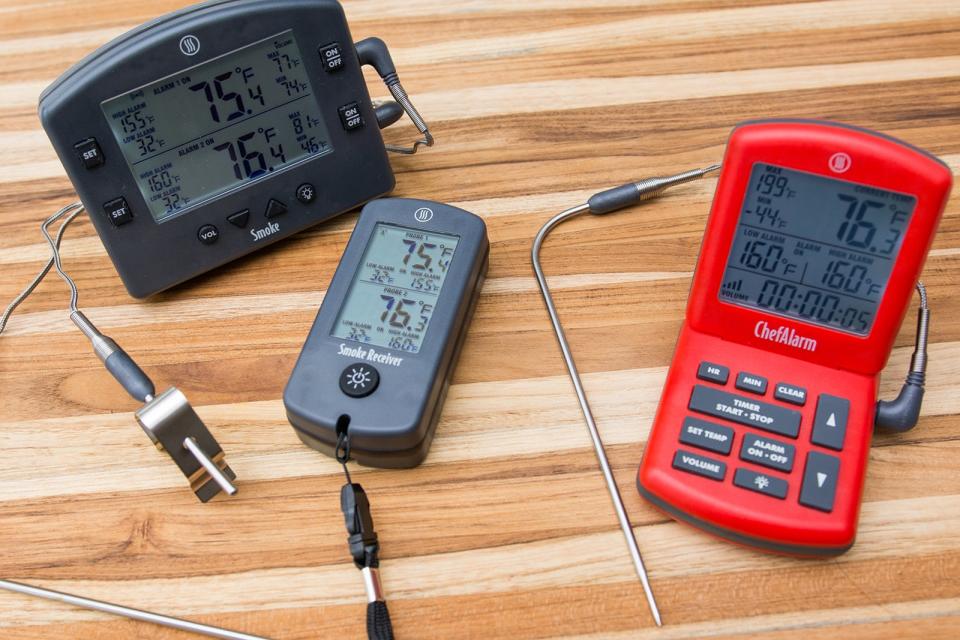
If you want more features, like a timer or dual probes, we recommend two other models by ThermoWorks, the ChefAlarm and the Smoke. Both thermometers were very accurate in our tests, and both have longer probes than our main pick, but we found that they were slightly slower at reading temperatures. They both offer the same impressive temperature range as the Dot, from -58 °F to 572 °F for the probe and up to 700 °F for the cable.
In our tests, the ChefAlarm took a couple of seconds longer than the Dot to read temperatures, but it was just as accurate. The timer on this model is a nice addition (it can handle countdowns as long as 99 hours, 59 minutes), and the backlit screen is handy for outdoor grilling at night. The ChefAlarm also allows you to set the minimum and maximum temperatures, which have corresponding alarms to alert you when they've been reached. The two strong magnets on the back of the unit keep it in place when attached to the side of an oven or grill; the digital unit is also hinged, so you can lay it flat or adjust it to a specific angle. Our testers liked that the ChefAlarm thermometer comes with a case to hold both the probe and the digital unit. This model is Cook's Illustrated's favorite probe thermometer, too. However, in spite of the ChefAlarm's various benefits, we think most people will be fine with our pick.
Like the ChefAlarm, the Smoke has a backlit screen and volume control. But in contrast to our other picks, the Smoke can operate via a wireless receiver and has two channels to accommodate multiple probes: one probe to take the internal temperature of the meat, and an air probe for measuring the ambient temperature of the oven, grill, or smoker. The Smoke also allows you to set the minimum and maximum temperatures for each probe, which sound corresponding alarms when the set temperatures have been reached. In our tests, the Smoke maintained its wireless connection for an unobstructed distance of 350 feet, more than double the distance of the Weber iGrill 2. As we stated earlier, we don't think you need these features, but if you really want them, the Smoke was the best model we tested that offers them. Considering that this thermometer is also $60 more than the Dot, we think it makes sense only for grill and smoker enthusiasts.
If you want to monitor the Smoke's probes from any distance, ThermoWorks also offers the new, exorbitantly priced Smoke Gateway. According to ThermoWorks, "Smoke Gateway easily pairs via radio frequency (RF) with your existing Smoke thermometer. It then pairs with your Wi-Fi network to send temperatures and alerts to the Smoke Gateway app on your smartphone or smart device." We tried out the Smoke Gateway and found that it works fine, but we think it's a pricey convenience item that most people can do without.
Coincidentally, all of our picks are manufactured by ThermoWorks. They were far and away the best thermometers we tested. None of the other models compared to our picks in terms of speed, accuracy, and ease of use.
Care and maintenance
Before you use any thermometer, "you should ALWAYS make sure they are calibrated," said chef Janet Crandall. "A thermometer should read 32 °F in ice water, and 212 °F in boiling water." Most probe thermometers come calibrated, but it's still good to double-check before using.
It goes without saying, but never put the digital unit in an oven, grill, or smoker, or attach it to the lid of a grill, which can exceed 700 °F and melt it. Though the ThermoWorks cables are heat resistant to 700 °F, avoid placing them directly on a grill grate or oven rack, as doing so could damage their inner insulation. Also, straighten any kinks in the cable, which can break the inner wires if left alone. And never place a probe tip directly into hot coals or fire.
Always use a hot pad or oven mitt when retrieving a probe thermometer from the oven or grill. To prevent cross-contamination, be sure to properly sanitize the probe after each use.
The competition
The newest offering from ThermoWorks, the Signals 4-Channel BBQ Alarm Thermometer, is essentially the next step up from the ThermoWorks Smoke. It comes with four probes (one is an air probe) instead of two, all of which you can use simultaneously. It can also connect to an app on your phone via Bluetooth or Wi-Fi, which is nice if you're smoking meat and you want to monitor its progress from inside. But at $230, this four-channel thermometer is overkill unless you're on a competitive barbecue team, or if you plan to cook several cuts of meat at once regularly.
As mentioned above, the ThermoWorks BlueDot is the same as our main pick, except it can connect to an app on your phone via Bluetooth, which allows you to monitor the food you're cooking from a distance. ThermoWorks advertising says the BlueDot can stay connected for an unobstructed distance of 95 feet, but in our tests it lost the connection around 75 feet. We think most people will be happy with our main pick, the ThermoWorks Dot, which currently costs about $20 less.
The Lavatools Carbon Lite uses Bluetooth to connect to an app on your phone, but unlike other models we tested, it lacks manual controls. This model was much slower at reading temperatures than our picks. And though the preset temperatures on the app are helpful for beginner cooks, we found the layout confusing when setting custom temperatures. The thermometer kept its connection for up to 250 feet in our tests, which was 100 feet less than the ThermoWorks Smoke. It also has a narrower temperature range than the ThermoWorks thermometers we recommend.
The Lavatools Element was very slow at reading temperatures, taking up to 15 seconds in some instances. The temperature readings don't gradually increase either, jumping from number to number, which makes it difficult to anticipate temperature changes. Its digital controls aren't as intuitive to use as our picks' and the buttons are very difficult to press.
We found the receiver of the ThermoPro TP20 difficult to read because it alternated the display of both probe temperatures, which we found confusing. The membrane-sealed push button on the receiver also became worn after only a few uses.
Since the ThermoPro TP16 is so light and the cable is so stiff, the unit moved around the counter when we opened and closed the oven door. We also found that the stand put the digital screen at an awkward angle for reading.
In our tests, when we placed the Maverick ET-732 in a pot of boiling water, it took 21 seconds to reach 212 °F, a considerably slower result than we got from our main pick. This model's digital unit also lacks magnets for keeping it secure on an oven or grill.
The Maverick ET-733 suffered notable delays in reading temperatures. In one instance, the thermometer jumped from 73 °F to 214 °F, showing no temperatures in between. This model is also covered by a paltry 90-day warranty.
Although the Taylor 1478-21 Digital Cooking Thermometer has intuitive buttons and a simple design, it's slow at reading temperatures. It also can't work on a hot grill because the cable and probe are heat resistant to only 392 °F.
In our tests the Polder THM-362-86 Classic Digital Thermometer/Timer was quick to respond to temperature adjustments, but the probe and cable are heat resistant to only 392 °F, making this model unsuitable for high-temperature cooking.
The Weber iGrill 2 was very slow to read temperatures and had the shortest probes of all the models we tested. We found that it began to lose its wireless connection at around 125 feet.
Designed specifically for the Weber Genesis II and Genesis II LX gas grills, the Weber iGrill 3 is not appropriate for most people. Also, since this model lacks a digital display on the unit, you can view the thermometer's temperature readings only via an app on your phone.
We didn't test the Meater Probe thermometer because it can read a maximum internal temperature of only 212 °F, which means it's not suitable for high-temperature cooking. Also, its probe is so egregiously thick, it would be like sticking a Sharpie into your meat.
We opted not to test the Loki Sphere Bundle because it's very expensive and has a smaller temperature range than our current picks. This model can accommodate up to four probes at once, but that's overkill for what most people need.
This guide may have been updated by Wirecutter. To see the current recommendation, please go here.
When readers choose to buy Wirecutter's independently chosen editorial picks, Wirecutter and Engadget may earn affiliate commissions.
